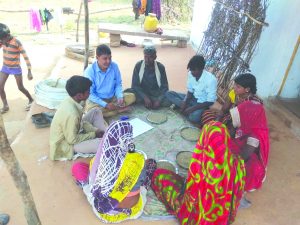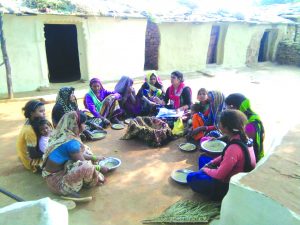 Ram Dulari, a sahariya tribal woman in her fifties and resident of Macha Khurd village in Madhya Pradesh’s Shivpuri district, was overjoyed when she received kodo millet seeds from Ajay Singh Yadav, the district co-ordinator of Vikas Samvad Samiti (VSS).
Ram Dulari, a sahariya tribal woman in her fifties and resident of Macha Khurd village in Madhya Pradesh’s Shivpuri district, was overjoyed when she received kodo millet seeds from Ajay Singh Yadav, the district co-ordinator of Vikas Samvad Samiti (VSS).
The samiti is a state-based non-profit organisation that addresses the twin issues of food scarcity and malnutrition among the poor tribal population. Dulari’s happiness knew no bounds as kodo seeds were over in her village and it was difficult for poor farmers like her to get access to new seeds for cultivation. But kodo seeds brought from Satna in June 2018 solved the problem. At the same time, it gave rise to the idea of seed conservation to ensure future supply.
To address nutrition security in 15 villages of Pohari block in Shivpuri dominated largely by the malnourished Sahariyas, VSS, in a joint collaboration with CRY, launched the concept of community-based seed banks in October 2018. For the project, seeds banks were initially set up in two villages and later expanded to 13 others. Under this initiative, Sahariya families collect and donate seeds for the banks to be used in the fields during times of cultivation. So far, in five villages seeds worth 60 kg have been saved.
These seed banks focus on collection of such grain varieties that used to be consumed by the Sahariyas for ages, but at present the consumption level has declined due to a number of factors. Right now, apart from seed conservation, the project is also promoting cultivation of different types of grains in these villages. Earlier, VSS had trained the Sahariyas in cultivation as well as in establishing kitchen gardens with the help of the agriculture and horticulture departments. About 429 families were targeted for kitchen gardens.
Seed collection
Mehra village resident Sitaram Adivasi, who is part of the seed conservation campaign, says that the collection process started last year during which the Sahariyas collected bajra (pearl millet) seeds. In these villages, the collected seeds are kept in koti or kanai, containers made of mud found in Sahariya homes.
According to Yadav, kotis are bigger in size than kanais, but both are used for storage. Right now, seed collection is a small enterprise involving 35 villagers in Mehra under which millet seeds such as bajra and kodo are being conserved so that farmers get adequate seeds at the time of sowing. The villagers are also saving the seeds of urad. Till now, 20 kg bajra and 3 kg urad seeds have been saved in the village. The sahariyas, who come under the primitive tribal group, have no steady source of income in June-July. So, the saved seeds help them in cultivation.
Atar Singh Adivasi, a resident of Mehra village, takes care of a seed bank at his home. “Initially, we asked for seeds from those farmers who had them and then started conservation. Now, about 10 people can use the seeds during sowing, all thanks to the seed bank, which stores seeds of kutki (small millet), and groundnut, apart from kodo and bajra,” he says.
He owns a plot of land about an acre and also works as an agricultural labourer on bigger plots. Adivasi mainly focuses on bajra. He started conserving seeds after realisation dawned upon him that the fields of the Sahariyas were mostly lying barren due to the lack of seeds. As we did not have seeds, the seed banks are helping us conserve them. At the time of harvest, farmers readily give us seeds for conservation, he explains. Generally, the beneficiary has to give back double the amount of seeds. So, if 2 kg seeds are given to a farmer, the person has to give back 4 kg after the harvest.
Seed conservation started with Yadav initially getting 5 kg seeds from Satna for sowing that included seeds of kodo as well as paddy. “When I talked to the villagers, especially women, they told me that they used to eat a lot of millets and be healthy. Eating kodo rice during delivery was normal among pregnant women. But gradually it became a rare practice as there were no buyers. So, they started growing soybean and groundnuts for profit.
Gradually, millets disappeared from the scene,” the VSS coordinator explains. But in these areas, even the cattle used to be fed millets for strength. So, it was a hopeless situation. However, cultivation restarted after kodo seeds arrived from Satna.
As the Sahariyas are poor, very little grows in their fields. They are unable to use a lot of inputs for higher yields. So, there is more focus on millets as they grow easily and are highly nutritious.
Currently, to oversee the programme, there is a core group in every village comprising four men and an equal number of women in whose houses the seed banks are situated. There is only one seed bank in each village.
“The best thing about this initiative is that we didn’t force anyone. We just spread the message of seed conservation. The core group is in full charge. When the sowing season arrived, those interested were given seeds. Kodo was sown in July 2018 and it was ready by October when the seed banks formally started functioning. The main focus is on the Sahariyas, as they suffer from malnutrition. They are mostly labourers and migrate to Uttar Pradesh and Rajasthan. Most of them own poor quality small plots of lands even less than an acre,” Yadav says.
At present, the focus is more on seed multiplication and conservation. Last time, many farmers sowed kodo, but failed to take care of the crop. So, this time, kodo was grown only on a small plot of land belonging to Ramesh Adivasi of Macha Khurd village.
To bring back millets to the mainstream, some non-profits are making wholehearted efforts. In the Baiga areas of Madhya Pradesh, non-profit Nirman is working on the revival of sikiya and sawa millets for promoting improved nutrition.
India’s rich association with millets cannot be denied, but our agriculture policy has favoured wheat and rice. In fact, both kodo and kutki are making a comeback in the tribal regions of Madhya Pradesh as more and more women are realising their nutritional benefits.
letters@tehelka.com













